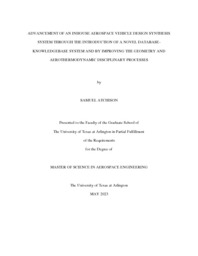| dc.description.abstract | Throughout the years of aerospace vehicle design, the process in which a vehicle is designed has drastically improved from being primarily developed through trial and error, to using sophisticated synthesis systems. While the trial-and-error process had its uses with providing the fundamental knowledge of how aircraft behave and can be designed, the increase in knowledge and technology allowed the possibility of more vehicle configurations to be explored without the need to build each one. This increase should have led to a revolution of vehicle designs, and while there have been some novel ones, it seems that the general design of aerospace vehicles has begun to stagnate. In short, as our knowledge of aerospace vehicle design has increased, the design freedom for new vehicles has decreased.
One possible reason for this contradictory situation is that as the knowledge of a specific vehicle configuration grew, it reduced the need or the want to explore beyond it. Keeping the same configuration, or at least close to it, reduces the risk involved with its design, but other vehicle configurations that may potentially prove to be more beneficial are left unexplored. Another possible reason is that the full knowledge from each vehicle design is not completely passed down from generation to generation. While the knowledge of design has generally increased over the years, this issue with knowledge retention keeps designers from reaching their full potential by having to redesign past vehicles and configurations. These issues are especially prevalent for high-speed aerospace vehicles.
The Aerospace Vehicle Design (AVD) Laboratory has been tackling these issues for many years, and their solution was the Aerospace Vehicle Design Synthesis (AVDS) system. This synthesis system provides a generic design methodology to open up the solution space topographies and allow more unconventional vehicle configurations to be explored. Each generation of AVD researchers has improved upon this system to increase its capabilities, and the research presented herein introduces the author’s contribution.
First, to further help the knowledge retention issue, the Vehicle Configuration Compendium (VCC) is introduced. This compendium is a self-contained parametric library that combines a comprehensive database and knowledgebase of past-to-present aerospace vehicles to aid design engineers by making the past always available. The power of this system was shown within a NASA-funded study regarding hypersonic commercial transportation, with two of the vehicle verification studies out of seven provided herein.
Lastly, to improve the capabilities of AVDS to increase the solution space topographies, improvements of the geometry and aerothermodynamic disciplinary processes were accomplished. For the geometry disciplinary process, a parametric 3D modeling software was used in conjunction with AVDS to generate models that could be used for method and synthesis verification, synthetic data, and to use more complex scaling methods to explore more possibilities within a solution space. For the aerothermodynamics disciplinary process, a method was developed to calculate the structural index parameter, a parameter that can be used during conceptual design to represent the structural and aerothermal effects that the vehicle may experience. This method was verified against historic data from when it was originally developed, and new maps were generated to visualize how the parameter is affected by temperature, cruise time, and TPS material. These improvements to AVDS with the VCC and the disciplinary methods, will assist future researchers in their quest of aerospace vehicle design. | |


